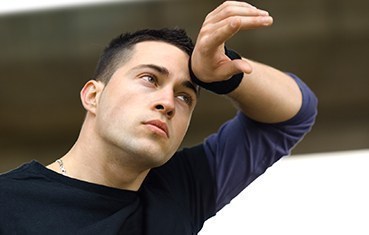
What is hyperhidrosis?
This is a medical condition that causes excessive sweating. The word “hyperhidrosis” means too much (hyper) sweating (hidrosis).
Excessive sweating happens when a person sweats more than is necessary. Yes, it’s necessary to sweat. Sweating cools the body, which prevents us from overheating. People who have hyperhidrosis, however, sweat when the body does not need cooling.
Many people who have hyperhidrosis sweat from one or two areas of the body. Most often, they sweat from their palms, feet, underarms, or head. While the rest of the body remains dry, one or two areas may drip with sweat.
This excessive sweating can interfere with everyday activities. Hands can be so sweaty that it becomes difficult to turn a doorknob or use a computer. Sweat from the underarms often soaks through clothes, causing obvious sweat marks. Because the skin is often wet, skin infections can develop.
Signs and Symptoms
If you have this medical condition, you may notice:
- Visible sweating: When you are not exerting yourself, do you often see beads of sweat on your skin or have sweat-soaked clothing? Do you sweat when you’re sitting?
- Sweating interferes with everyday activities: Does sweating cause difficulty holding a pen, walking, or turning a doorknob? Does sweat drip heavily on to your papers or computer?
- Skin turns soft, white, and peels in certain areas: Does your skin stay wet for long periods?
- Skin infections: Do you get frequent skin infections on the parts of your body that sweat heavily? Athlete’s foot and jock itch are common skin infections.
Two types of hyperhidrosis
Primary focal hyperhidrosis: This is the most common type. A person who has this type will notice that the excessive sweating occurs:
- In one or a few areas of the body: “Focal” means that the excessive sweating (hyperhidrosis) affects one or a few parts of the body. The areas of the body most commonly affected are the underarms, hands and/or feet, and forehead.
- On both sides of the body: If the excessive sweating occurs in the underarms, the person usually notices both underarms sweat excessively. The same holds true for the hands and feet.
- After waking up: Sweating may begin soon after the person wakes up, but the person usually does not notice damp sheets or wet clothing unless the room is hot.
- At least once a week: For many people, it occurs much more often.
- This type of hyperhidrosis usually begins when the person is a child or adolescent. Most people who have this type are otherwise healthy. In medical terminology, the word “primary” means that the cause is not another medical condition.
Secondary hyperhidrosis: In medical terminology, “secondary” means that the excessive sweating (hyperhidrosis) has an underlying cause. The cause could be a:
- Medical condition
- Side effect of taking a medicine or food supplement
Medical conditions that can cause excessive sweating include:
- Diabetes
- Frostbite
- Gout
- Injury, such as head trauma caused by an accident
- Menopause
- Obesity
- Overactive thyroid (hyperthyroidism)
- Tumor
If a person has this type of hyperhidrosis, the person may notice:
- The entire body sweats excessively: Sometimes, only parts of the body sweat.
- Sweating occurs during sleeping: If you sweat excessively while asleep, it is important to see a dermatologist to learn why this happens.
This type of sweating usually begins when the person is an adult. It also may begin after an accident or frostbite. Many medicines also can cause this type of hyperhidrosis.
Anxiety and embarrassment
Both types of hyperhidrosis can cause people to feel extremely anxious and embarrassed. Students often avoid raising their hand during class. Many teens never date. Adults may hide the sweat stains by wearing layers of clothing or changing frequently throughout the day.
How do dermatologists diagnose hyperhidrosis?
To diagnose this condition, a dermatologist gives the patient a physical exam. This includes looking closely at the areas of the body that sweat excessively. A dermatologist also asks very specific questions. This helps the doctor understand why the patient has excessive sweating.
Sometimes medical testing is necessary. Some patients require a test called the sweat test. This involves coating some of their skin with a powder that turns purple when the skin gets wet.
To find an underlying medical condition, other medical tests may be necessary.
How do dermatologists treat hyperhidrosis
Treatment depends on the type of hyperhidrosis and where the excessive sweating occurs on the body. Your dermatologist also considers your overall health and other factors.
Treatments that dermatologists use to help their patients control hyperhidrosis include
Antiperspirants
This may be the first treatment that a dermatologist recommends. It is affordable. When applied as directed, an antiperspirant can be effective. Your dermatologist may recommend a regular or clinical-strength antiperspirant, such as Secret Clinical Strength. Some patients need a stronger antiperspirant and receive a prescription for one.
Uses: Apply to underarms, hands, feet, or hairline
How it works: The antiperspirant sits on top of your skin. As you sweat, the antiperspirant is pulled into your sweat glands. This plugs the sweat glands. When your body senses that its sweat glands are plugged, this should signal your body to stop producing so much sweat.
Side effects:Where they apply the antiperspirant, some people develop:
- Burning sensation
- Irritated skin
If these occur, be sure to tell your dermatologist. Changing how you use the antiperspirant can reduce these side effects.
Iontophoresis (the no-sweat machine)
If excessive sweating affects your hands, feet, or both areas, this may be an option. You will use this treatment at home. It requires you to immerse your hands or feet in a shallow pan of tap water. As you do this, a medical device sends a low-voltage current through the water.
Many people obtain relief. Some people dislike that this treatment can be time-consuming.
Uses: Hands and feet
How it works: The electric current shuts down the treate sweat glands temporarily
Most people need about 6 to 10 treatments to shut down the sweat glands. To get improvement, you begin by using the device as often your dermatologist recommends. At first, you may need 2 or 3 treatments per week. A treatment session usually takes 20 to 40 minutes.
Once you see results, you can repeat the treatment as needed to maintain results. This can range from once a week to once a month.
If this treatment is right for you, your dermatologist will teach you how to use the device and give you a prescription so that you can buy one. Some patients also receive a prescription for a medicine that they add to the tap water.
Side effects: Some people develop:
- Dry Skin
- Irritated skin
- Discomfort during treatment
If you experience any side effects, tell your dermatologist. Making some changes often eliminates these side effects
Brella Patch
The Brella SweatControl Patch is an FDA-cleared in-office approach to sweat control that is safe, comfortable, non-invasive (needle-free), aluminum-free, and affordable, with results lasting three to four months. After just one treatment, the SweatControl Patch targets your overactive sweat glands to significantly reduce sweat production and give you back control. To learn how it works, click here. Brella is FDA cleared to reduce excessive underarm sweating in adults due to primary axillary hyperhidrosis. Brella is proven to significantly reduce excessive underarm sweating and significantly improve confidence and daily living.
To learn more about excessive underarm sweating and if you may be a candidate for Brella, call us at 757-313-5813.
Botulinum toxin injections (Botox)
Your dermatologist can inject a weak form of this medicine into your underarms. To treat excessive sweating, a patient will need to have very tiny amounts injected in many areas of the underarms. When performed properly, patients have little pain or discomfort.
Uses: Underarms
The U.S. Food and Drug Administration (FDA) has approved this treatment for the underarms. Findings from some research studies suggest that this treatment may be effective for other areas of the body. It may help post-menopausal women who sweat excessively on the head. It may be effective for excessive sweating that affects the hands and feet.
How it works: The injections temporary block a chemical in the body that stimulates the sweat glands. Most patients notice results 4 to 5 days after receiving treatment.
Reduced sweating lasts about 4 to 6 months — and sometimes longer. When the excessive sweating returns, you can be retreated.
Side effects: The most common one is temporary muscle weakness, which can occur when this is injected into the hands.
Prescription medicine
Some patients receive a prescription for a medicine that temporarily prevents them from sweating. These medicines work throughout the body.
Uses: These medicines can effectively treat sweating that involves entire body. This medicine also can be an effective treatment for post-menopausal women who sweat excessively only from their head.
How it works: These medicines prevent the sweat glands from working. Athletes, people who work in a hot place, and anyone who lives in a warm climate should use extreme caution when using this treatment. The body may not be able to cool itself.
Side effects: The medicines that prevent the sweat glands from working can cause:
- Dry mouth
- Dry eyes
- Blurry vision
- Heart palpatations (abnormal heartbeat)
The risk of side effects increases with higher doses. Before taking this medicine, you should talk with your dermatologist about your individual risks and benefits.
miraDry
miraDry is the only non-surgical, FDA-cleared treatment that will free you from the bothersome problems of underarm sweat. By eliminating the sweat and odor glands, you can feel confident that your underarms will remain dry in any situation.” Click here to learn more about miraDry as a treatment option.
Outcome
By seeing a dermatologist, many people find treatment that effectively controls their excessive sweating. This often greatly improves their quality of life.
Many people control their hyperhidrosis by combining treatment with tips for managing.



